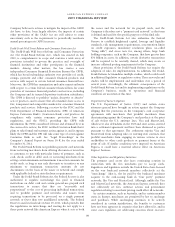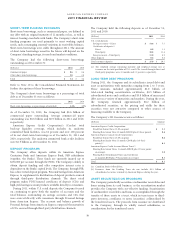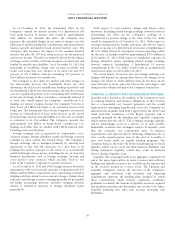American Express 2011 Annual Report Download - page 30
Download and view the complete annual report
Please find page 30 of the 2011 American Express annual report below. You can navigate through the pages in the report by either clicking on the pages listed below, or by using the keyword search tool below to find specific information within the annual report.
AMERICAN EXPRESS COMPANY
2011 FINANCIAL REVIEW
The following table presents the regulatory risk-based capital
ratios and leverage ratio for the Company and its significant
bank subsidiaries, as well as additional ratios widely utilized in
the marketplace, as of December 31, 2011. As noted below,
certain of these ratios are based on shareholders’ equity of $18.8
billion as of December 31, 2011.
Well-
Capitalized
Ratios(a)
Ratios as of
December 31,
2011
Risk-Based Capital
Tier 1 6%
American Express Company 12.3%
Centurion Bank 18.8%
FSB 17.4%
Total 10%
American Express Company 14.3%
Centurion Bank 20.1%
FSB(b) 19.8%
Tier 1 Leverage 5%
American Express Company 10.2%
Centurion Bank 19.1%
FSB 18.4%
Common Equity to Risk-Weighted Assets
American Express Company 15.6%
Tier 1 Common Risk-Based(c)
American Express Company 12.3%
Tangible Common Equity to
Risk-Weighted Assets(c)
American Express Company 12.0%
(a) As defined by the Company’s primary regulator.
(b) Refer to Note 23 to the Consolidated Financial Statements for further
discussion of FSB’s Total capital ratio.
(c) Refer to page 29 for a reconciliation of Tier 1 common equity and tangible
common equity, both non-GAAP measures.
Basel III, when implemented by the U.S. banking agencies and
fully phased-in, will require bank holding companies and their
bank subsidiaries to maintain substantially more capital than
prior requirements, with a greater emphasis on common equity.
While final implementation of the rules related to capital ratios
will be determined by the Federal Reserve, the Company
estimates that had the new rules (as currently proposed) been in
place during the fourth quarter of 2011, the reported Tier 1 risk-
based capital and Tier 1 common risk-based ratios would decline
by approximately 30 basis points. Similarly, the reported Tier 1
leverage ratio would decline by approximately 160 basis points.3
The estimated impact of the Basel III rules will change over time
based upon changes in the size and composition of the
Company’s balance sheet as well as based on the U.S.
implementation of the Basel III rules; and the estimated impact
for the fourth quarter of 2011 is not necessarily indicative of the
impact in future periods.
3The proposed capital ratios are non-GAAP measures. The Company believes
the presentation of the proposed capital ratios is helpful to investors by
showing the impact of Basel III, assuming the new rules as currently proposed
are implemented by the Federal Reserve.
The following provides definitions for the Company’s regulatory
risk-based capital ratios and leverage ratio, which are calculated
as per standard regulatory guidance if applicable:
Risk-Weighted Assets — Assets are weighted for risk according to
a formula used by the Federal Reserve to conform to capital
adequacy guidelines. On and off-balance sheet items are
weighted for risk, with off-balance sheet items converted to
balance sheet equivalents, using risk conversion factors, before
being allocated a risk-adjusted weight. The off-balance sheet
items comprise a minimal part of the overall calculation. Risk-
weighted assets as of December 31, 2011 were $120.9 billion.
Tier 1 Risk-Based Capital Ratio — The Tier 1 capital ratio is
calculated as Tier 1 capital divided by risk-weighted assets. Tier 1
capital is the sum of common shareholders’ equity, certain
perpetual preferred stock (not applicable to the Company), and
noncontrolling interests in consolidated subsidiaries, adjusted
for ineligible goodwill and intangible assets, as well as certain
other comprehensive income items as follows: net unrealized
gains/losses on securities and derivatives, and net unrealized
pension and other postretirement benefit losses, all net of tax.
Tier 1 capital as of December 31, 2011 was $14.9 billion. This
ratio is commonly used by regulatory agencies to assess a
financial institution’s financial strength and is the primary form
of capital used to absorb losses beyond current loss accrual
estimates.
Total Risk-Based Capital Ratio — The total risk-based capital
ratio is calculated as the sum of Tier 1 capital and Tier 2 capital,
divided by risk-weighted assets. Tier 2 capital is the sum of the
allowance for receivable and loan losses (limited to 1.25 percent
of risk-weighted assets) and 45 percent of the unrealized gains on
equity securities, plus a $750 million subordinated hybrid
security, for which the Company received approval from the
Federal Reserve for treatment as Tier 2 capital. Tier 2 capital as
of December 31, 2011 was $2.4 billion.
Tier 1 Leverage Ratio — The Tier 1 leverage ratio is calculated by
dividing Tier 1 capital by the Company’s average total
consolidated assets for the most recent quarter. Average total
consolidated assets as of December 31, 2011 were $146.3 billion.
28
























